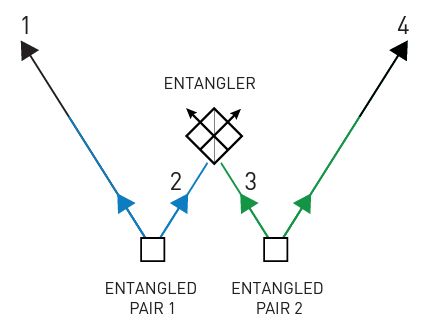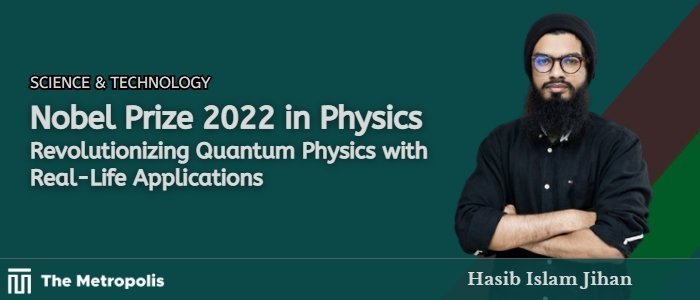Hasib Islam Jihan –
The field of physics saw two significant transformations during the beginning of the 20th century. The first was Einstein’s General Theory of Relativity dealing with the universal realm of physics. And the second was Quantum Theory, which put out the idea that energy exists in the form of distinct packets, referred to as “quanta”.
Albert Einstein believed that describing a reality needs accurate predictions followed by precise observations. However, Neils Bohr opposed this school of thought with the view that quantum interactions cannot be directly observed, rather it needs predictions about their occurrence probability to describe reality. The definition of reality was the center of a heated debate in the 1930s concerning Albert Einstein against Niels Bohr and Erwin Schrödinger.
According to Einstein, every part of reality has a distinct and complete existence whether we observe them or not. All things, be it the moon or a single photon of light, ought to have well-defined characteristics that can be measured. However, Bohr and Schrödinger, argued that reality seemed to be essentially ambiguous; a particle does not have certain attributes until it is measured.
The idea of entanglement is the key distinction between the behavior of quantum systems (Bohr) and that of classical rigid entities (Einstein). Quantum entanglement occurs when two subatomic particles are permitted to coexist in a shared state with complementary features. As a result, by measuring the attributes of one particle, one can infer the characteristics of the other particle. It was first developed by Austrian physicist Erwin Schrödinger which led to his famous “cat paradox”.

The Nobel Prize for Physics in 2022 was awarded to the physicists John Francis Clauser, Alain Aspect, and Anton Zeilinger for proving the presence of entanglement. Emphasizing the importance of this work, Professor Thors Hans Hansson, a member of the Nobel Committee for Physics, told, “This work has made clear what quantum mechanics really means”.
Now let us understand a bit more about quantum entanglement by considering an object breaking into two particles. If one of them has a spin of -1 (anti-clockwise), the other one will certainly be +1 (clockwise) as per the rule of angular momentum conservation. This is like knowing which shoe is lost from a pair by observing which one is available at hand.
Now imagine two particles are located at light-year distances from each other. If we observe one, located at the earth, rotating anti-clockwise, the other one at the distance will immediately know it has to spin in a clockwise direction.
Here comes the confusion! Because here information is traveling at a speed higher than that of light, which is not possible as per Einstein’s theory of relativity.
Einstein named this event a “spooky action at a distance”. According to Einstein, the impact was caused by hidden variables or instructions that had already established the states of the particles. This would imply that teleportation was not necessary.
Einstein along with his fellow researchers Boris Podolsky and Nathan Rosen, developed a thought experiment named “EPR Paradox” to show the inherent conceptual challenges in quantum theory. According to this theory, no matter how far apart two particles are, the outcome of a measurement of one particle in an entangled quantum system can instantly affect another particle.
Since Einstein and his colleagues published their original EPR paper, there have been many theoretical and experimental advancements, and most physicists now see the so-called “paradox” more as an illustration of how quantum mechanics violates classical physics than as proof that quantum theory is fundamentally flawed, as Einstein had originally intended.
Northern Irish physicist John Stewart Bell put out a deciding thought experiment in 1964. He derived a mathematical constraint, called “Bell’s Inequalities”, which states that if there are hidden variables, the correlation between the results of several measurements will never be higher than a certain number.
If the inequality held, it would support Einstein’s theory that the universe is classical and is supported by “local hidden variables”. However, if the inequality was broken and the correlation increased, as predicted by quantum theory, the universe is fundamentally probabilistic and quantum mechanical, just as Bohr or Schrödinger asserted.
Bell’s thought experiment was first brought from the page into the laboratory by American physicist John Francis Clauser of Lawrence Berkeley National Laboratory and the University of California, Berkeley. Clauser employed calcium atoms that, after being exposed to a particular light, could release entangled photons. To determine the polarization of the photons, he put up filters on either side. After taking several measurements, he was able to demonstrate in 1972 that photons’ states appeared correlated in a way that precluded any hidden-variable theory, thus violating Bell’s inequality.

Yet, this experiment contained several loopholes that could have allowed hidden-variable theories to still be valid. It was suggested that either the photons detected were not a representative sample of all photons released by the source (the detection flaw), or that previously considered independent aspects of the experiment were linked (the locality loophole).
To close these gaps, French physicist Alain Aspect at the Université Paris-Sud in Orsay, France, devised an experiment in 1982. He created a new method of stimulating the atoms so they released entangled photons at a greater rate by utilizing enhanced methods and novel equipment. He could change the measurement parameters after an entangled pair had left its source, thus the parameters in place at the time they were released had no bearing on the outcome. With this configuration, Aspect was able to establish breaches of a Bell inequality with a high degree of accuracy.

Aspect’s experiments were not ideal because the entangled photons were only 12 meters apart, and among other technical issues, the locality loophole was still there.
Austrian physicist Anton Zeilinger at the University of Innsbruck, Austria, was able to close this gap in 1998. By shining a laser on a unique crystal, he produced entangled pairs of photons and then switched between measurement modes using random numbers. After this, Zeilinger has carried out several loophole-free tests, each one more ingenious than the last, which have disproved theories involving hidden variables. In one particular experiment, signals from distant galaxies were utilized to regulate the filters and guarantee that the signals could not interfere with one another.

Besides improving Clauser’s and Aspect’s experiments, Zeilinger used entanglement for developing quantum teleportation to transport information from an object to a new location where the thing is reconstructed.
Zeilinger has also been a pioneer in the study of quantum cryptography and communication. To establish a secure key (a secret message that is destroyed by any attempted interception) between La Palma and Tenerife in Spain, which are separated by 144 km, he used an entanglement-based Quantum Key Distribution (QKD) protocol and an optical free-space link in 2006.
Later in 2017, he worked with his former student Jian-Wei Pan to share a QKD key (75-minute video conversation) between Beijing and Vienna, located 7400 kilometers apart, using China’s Micius quantum communications satellite. The experiment paved the door for virtually impenetrable cryptography, which was ensured by the well-proven principles of quantum mechanics.
The combined work of the 3 researchers has made a significant contribution to the field of quantum information science in making advancements in quantum computers, quantum networks, and secure quantum-encrypted communication. Ultra-secure, encrypted communications over long distances in a quantum internet have now become a reality.
Talking about the importance of these works, Chair of the Nobel Committee for Physics Anders Irbäck told, “It has become increasingly clear that a new kind of quantum technology is emerging. We can see that the laureates’ work with entangled states is of great importance, even beyond the fundamental questions about the interpretation of quantum mechanics”.
Hasib Islam Jihan is a science writer and a student of Mechanical Engineering at the Bangladesh University of Engineering and Technology (BUET). He is the Senior Olympiad Editor at Bangladesh Biggan Parishad and Physics Instructor at Monon Academy and Roots Edu.




